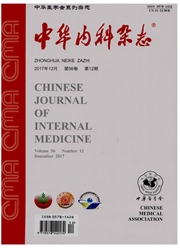

 中文摘要:
中文摘要:
目的 调查北京首都钢铁公司(以下简称首钢)腰背痛、脊柱关节炎(SpA)、强直性脊柱炎(AS)的患病率及就诊情况.方法 根据Rudwaleit等制定的腰背痛和SpA问卷调查表,以分工厂为单位对所有在职及退休职工以非抽样普查方式进行调查.共对12 125人进行4级调查,对筛出的疑似者进行骶髂关节X线及HLA-B27检查.SpA的分类标准采用2009年国际强直性脊柱炎协会(ASAS)制定的标准.结果 腰背痛是常见症状,首钢职工的腰背痛发生率为42.7%,其中SpA患病率为0.58%,AS患病率为0.36%.由于认识不够,AS患者中已诊断并接受治疗者仅占28.9%.结论 首钢职工AS患病率与我国其他地区流行病学调查结果相近普通人群对SpA和AS的认知尚需进一步普及.
 英文摘要:
英文摘要:
Objective To investigate the epidemiological features of back pain, spondyloarthritis (SPA) and ankylosing spondylitis (AS) in Beijing Shougang district. Methods Set up Chinese version of questionnaire about incidence of spondyloarthro-pathy. Employees and retired ones were drawn out from subfactory units by non-randomized sampling. 15 357 subjects were investigated, of which 12 125 questionnaires were taken. Suspected cases were then screened with sacroiliac joint X ray and HLA-B27 testing. 2009 assessment in ankylosing spondylitis (ASAS) criteria were used for diagnosing SpA. Results Back pain is common with total incidence of 42.7%, and the most common pattern is mechanical pain. The incidence of SpA is 0.58% and that of AS is 0.36%, while only 28.9% AS patients had been diagnosed before and received treatment. Conclusion The AS incidence in Shougang district is similar with the epidemiological data got from other districts of China. And knowledge of SpA and AS is needed in China.
 同期刊论文项目
同期刊论文项目
 同项目期刊论文
同项目期刊论文
 期刊信息
期刊信息
